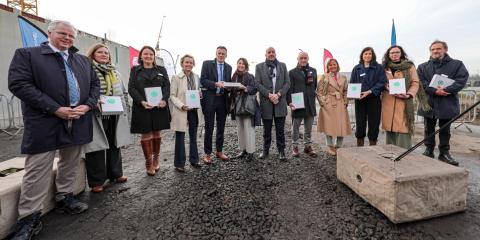Official foundation stone-laying of new prison in Antwerp

Belgian Minister of Justice: "The arrest house on Begijnenstraat is worn down and the staff has to work there in difficult conditions. Moreover, in such an environment it is difficult for detainees to rehabilitate. The decision to build a new prison was taken by the federal government back in 2008. Unfortunately, the dossier has encountered many difficulties and delays. But as Minister of Justice living in Antwerp, I am satisfied that construction is finally in full swing. By 2026, there should be a brand new and modern prison. An effective Justice not only punishes, but also puts inmates back on the right path. The complex will be divided into living units of 22 inmates each, so that we can diversify according to the target group and offer the right kind of detention. That is working towards a safe society. The new prison will be a model for a modern Justice Department."
Secretary of State for the Belgian Buildings Agency: "We are faced with a real challenge that we have to face immediately: on the one hand, we have to put all our energy into combating overcrowding and recidivism in prisons, and on the other, we have to ensure acceptable and humane working and detention conditions. From the beginning, this has clearly been my priority at the Buildings Authority. The proof is there, with a foundation stone laid for Antwerp's new prison. This is an important commitment to ensure that prisoners can serve their sentences in humane conditions. By investing in the modernisation of our prison infrastructure, we are strengthening our commitment to rehabilitation and social reintegration. As part of this fine project, the energy performance of the complex will be optimised, again reflecting our commitment to sustainability. I would like to thank everyone who contributes daily to this project. Together, we are working towards a more humane prison system that is resolutely focused on the future. It is with great conviction that I want to continue the mission to ensure fair justice, create an environment conducive to rehabilitation and ensure that all sentences can be served. All this must be done in partnership with the staff who work in our prisons every day and who must be able to benefit from a favourable environment to work in good conditions."
Kristien De Vries, project director of the Hortus Conclusus consortium: "Today we celebrate a milestone for Hortus Conclusus, for Jan De Nul and for EEG. We are proud that last fall we were able to begin construction of Antwerp's brand new state-of-the-art, highly advanced humane detention center. For Jan De Nul, this is the first public-private partnership for the realization of a complex building, after years of experience with PPP infrastructure projects. We are proud of our team, client confidence and, of course, our design of an inclusive prison where well-being and a positive mindset for successful rehabilitation and reintegration, are of central importance.”
People-oriented and modern concept
The new prison in Antwerp is adapted to the contemporary detention policies with the aim of keeping life in prison as close as possible to the 'normality' of the outside world. The design takes on the form and scale of a city with buildings, squares and streets, but without losing sight of the human scale. The outdoor space and landscape are also an essential aspect of this. For example, the cellular buildings are located on a raised ground level and are surrounded by poplars, thus making the prison wall less prominent. This form of humane detention focuses, on the one hand, on successful reintegration upon leaving prison and, on the other hand, on a modern working environment for prison employees.
During the construction phase there is a strong focus on prefabricating various building elements (such as walls and floors, as well as techniques), resulting in a more efficient process and faster project delivery. Similarly, the project connects to the local heat grid.
The prison will accommodate 440 inmates, divided into: one entity for 330 men, one entity for 66 women and one entity with a medical centre and a care-dependent unit for 44 people.
Public-private DBFM agreement
The Belgian Buildings Agency is the real estate developer of the prison complex and the Hortus Conclusus consortium is realizing it with a public-private DBFM agreement, where DBFM stands for Design, Build, Finance and Maintain. The consortium is thus responsible for the design, construction, financing and, for the next 25 years, maintenance of the prison. This form of contract was previously used when realising new prisons (Haren, Dendermonde, Beveren, Leuze-en-Hainaut and Marche-en-Famenne). The federal state pays the consortium an annual availability fee and at the end of the contract (after 25 years), it takes over the prison. In addition to maintenance, the private partner also provides some facility services to the FPS Justice.
Sustainability and innovation first: heat grid, rainwater reuse and 'Excellent' score
Sustainability and innovation are key in the realization of this project. Numerous actions are planned for this purpose, including: functional and compact construction, reduction of consumption through the choice of appliances and thorough energy management during operation, reuse of rainwater and gray water, a maximum use of natural daylight, addition of green zones and green roofs, as well as scenically thoughtful infiltration and buffering via a ring ditch and wadis, and the connection to the Blue Gate site's heat grid. This allows the prison to use waste heat from other users. Where no green roof is provided, solar panels will be installed.
With these efforts, the consortium commits to achieving an "Excellent" BREEAM (Building Research Establishment Environmental Assessment Method) rating with this prison.